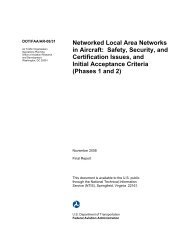Published Report (DOT/FAA/CT-94-36)
Published Report (DOT/FAA/CT-94-36)
Published Report (DOT/FAA/CT-94-36)
Create successful ePaper yourself
Turn your PDF publications into a flip-book with our unique Google optimized e-Paper software.
2.0 BASIC RISK COMPUTATION<br />
2.1 DEFINITION OF A TCV<br />
Although the definition of a collision of two aircraft is<br />
obvious, a definition which can be used in mathematical analysis<br />
is not as obvious and could be considered by some to be<br />
subjective. Since aircraft are basically long tubular structures<br />
with various protuberances, it is possible that two aircraft<br />
could pass very close to one another without touching. On the<br />
other hand, the aircraft could simply touch wing tips with the<br />
centers of gravity far removed. For this reason it was decided<br />
to simply place the evading aircraft in the center of a<br />
hypothetical sphere and determine whether or not the center of<br />
gravity of the blundering aircraft penetrates that sphere. It<br />
will be assumed that such a penetration would result in a<br />
collision. Obviously not all such penetrations would result in<br />
collisions, but in mathematical analysis some simplifying<br />
assumptions must be made. The choice of the radius of this<br />
sphere is somewhat subjective. It must be at least as large as<br />
the wingspan of the largest aircraft which will be involved in<br />
parallel approach operations, and it must be at least as large as<br />
the wingspan of aircraft in the foreseeable future. For these<br />
reasons the radius of the sphere was chosen to be 500 feet.<br />
Since an incursion of the blundering aircraft into the 500 foot<br />
sphere of the evader aircraft does not guarantee a collision, it<br />
will be called a Test Criterion Violation or TCV.<br />
2.2 DEFINITION OF WORST CASE BLUNDER<br />
Previous studies as well as the current study indicate that<br />
blunders in the 30' range are the most likely to result in a TCV.<br />
The probability of a TCV during a 20' or less blunder is<br />
considered to be remote. Not all 30' blunders will result in a<br />
flight by the blundering aircraft through the NTZ into the path<br />
of the evading aircraft just as not all swerves by automobiles<br />
toward the center median result in a crossing of the median.<br />
Simulations have shown that if the pilot of the blundering<br />
aircraft is able to return the aircraft to the course centerline<br />
because of controller intervention or personal initiative, the<br />
risk of collision is negligible. Therefore, a worst case blunder<br />
(WCB) is defined to be a 30' blunder in which the pilot of the<br />
blundering aircraft is unable to respond to a controller<br />
direction to return to course. The reason why the pilot may not<br />
respond could be a communications failure, a mechanical failure,<br />
a severe weather problem such as a thunderstorm, or a<br />
physiological problem of some member of the crew. For the<br />
purposes of this study, the reason will be simply referred to as<br />
no response.<br />
L-2

















